JDaddy, I have the Bowser 32 inch from 22 years ago....It’s not near the same construction as the Millhouse or the Ross TT. I would love to have the Millhouse buts it would be simply to much work to change. We did modify the Bowser, added scale rail, a ballbearing 3/8 shaft, floating Bogies, etc....We use the PTC 3 NYRS Indexing system. It works fine....If you use the big wooden wheel underneath and the friction motor, it wobbles....It was great for years ago, but the new ones today are much better. Lots more money....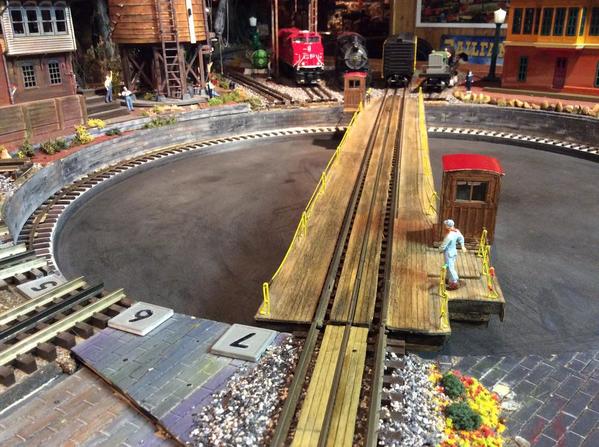
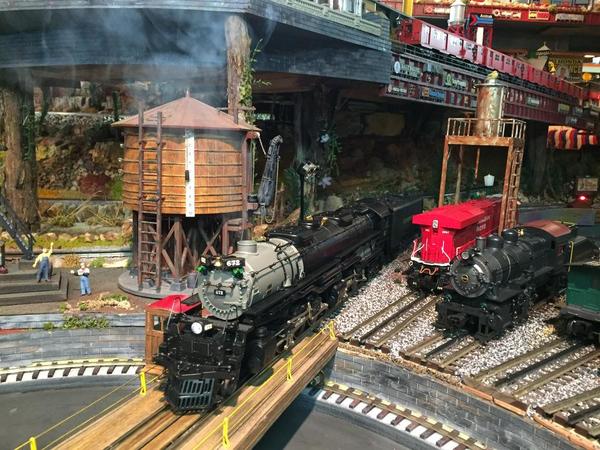

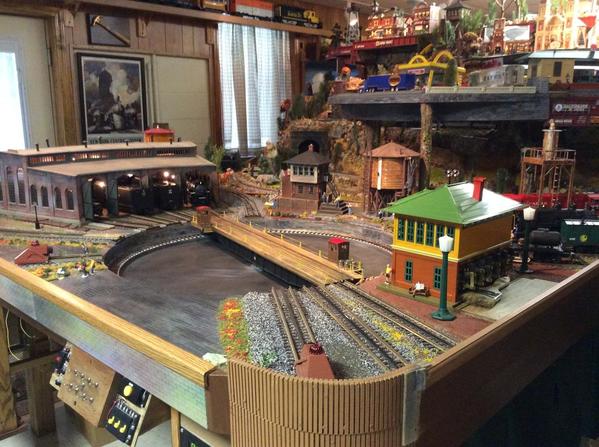
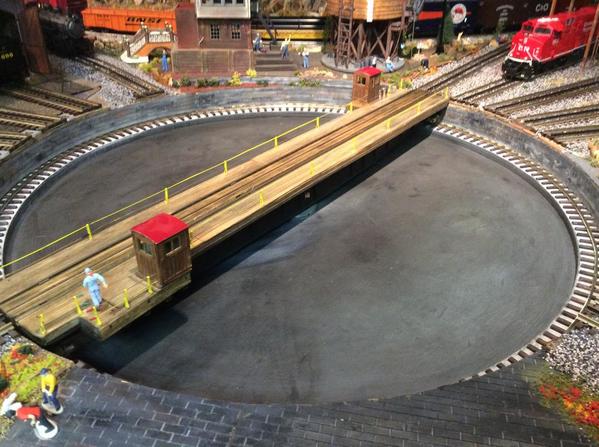
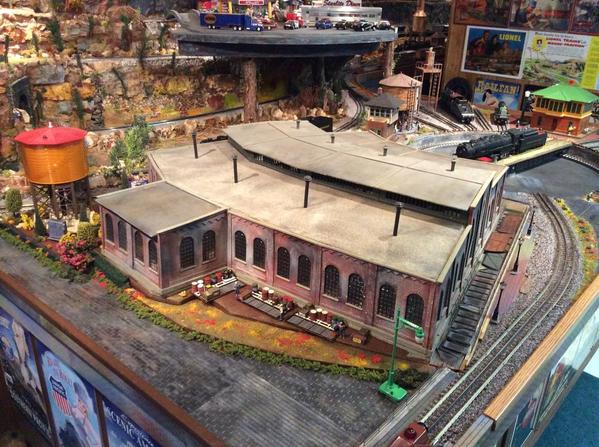
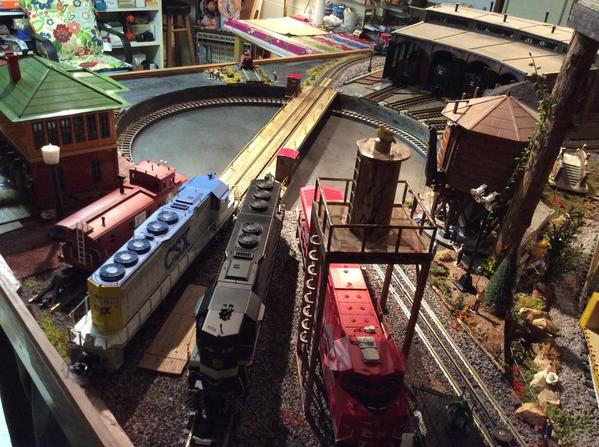
Korber 304, Base 3 stall kit, 304A, add one stall, and 304B extension, are available, and work well with any turntable 30" to 32". Space between the edge of the TT and the front of the Roundhouse is about 12", each TT spur track should center in the stall, at least up to 6, 8 stalls.




The 304B extension, add on.

Edit/Add 9:00AM 9/26/21. Older Diamond Scale TT, an assembled kit.
Attachments
RickM46,
I think you misunderstood Dr. Jack's earlier comment about not having to cut a circle. If I understand correctly, the Millhouse TT comes as a circular piece of aluminum with some connected aluminum feet. You have to cut a circle in your layout and push the aluminum circle up from the bottom so that the feet can be screwed to your benchwork.
On the other hand, the Ross TT comes already attached to a hunk of square plywood. Thus, instead of cutting out a circle, with the Ross you just cut out a square. Many people find a square cut less daunting than a circular cut.
Chuck
PRR1950, thanks for the clarification; good piece of info.
Also with a square you really don't have to cut and opening, just butt the square up to your table top.
I wanted a turntable to take to modular layout shows that was large enough for the articulated engines that club members were running. The turntable module had to be light to be lifted solo into my van for transport to shows, thin to allow additional modules and gear to be piled on in the van, durable to withstand handling, and simple to setup the morning of a show (less than an hour). The turntables demonstrated at York didn't satisfy those criteria.
With my previous experience cutting circles (AKA "router on a stick") in plywood while building Dobsonian telescopes, a turntable was just another circle cutting exercise, so I broke out the router. The turntable is 34.5" (Big Boy size) in a 4ft x 4ft module frame. The module sides frames are 1x4s with Luan plywood decking, selectively reinforced with a double layer. The assembled weight is at the limit of what I can manage. Construction uses a Dobsonian-inspired Formica + Teflon bearing. The floor of the turntable well (half the bearing) rotates (yes, its not prototypical unless you consider the B&O roundhouse turntable, but works well for this module). Appearance is tinplate with an Erector set operator's house, no fragile handrails, etc.
I motorized the turntable using a friction drive gear motor but discovered that large locomotive weights caused slipping (this IS prototypical) of the drive system. I considered a stepper motor, gear drive, and indexing but a solution that would eliminate slipping added unacceptable weight. I also found that casual operators at shows needed practice to control the motor for precise positioning. So, the motor was removed and the KISS principle now works. Operators can use the ever-reliable Armstrong motor and optical alignment techniques for rotating the bridge to the desired track.
Slip rings on the turntable bearing for bridge track power were considered but the initial solution (a quick hack) of extra length wires that could twist and untwist has lasted nearly two decades unchanged.
Wiring toggle switches to 16 tracks was a PITA.
If you are have woodworking skills (especially with a router), building a manual turntable for Big Boys is straight forward. Making it light and portable is an additional challenge. Wiring is always tedious. You can do this for $100 in materials and your labor. Scale appearance and detailing are up to you. The difference between a DIY manual drive solution and the $$$$ turntables shown at York are in the reliable motorization and indexing systems the vendors offer, plus the nice scale details. Having a turntable in your layout is a real plus. At our modular shows, turntable operations always draw a crowd of spectators and, with the slow speed operation of today's locomotives, running locos in out of storage tracks is fun. You really need one on your layout - DIY or buy one - you won't be disappointed.
John
hi thanks everybody for your input I'm totally overwhelmed for all you help and gives me many ideas which one company will work for my application
sincerely thanks
Alan
Sorry for the long delay. Here is my homemade 36" turntable with Atlas track. My MTH Premier C&O Allegheny fits on it. You can see it poking its nose out of the engine shed. The turntable still needs landscaping, as I am in the middle of reconstructing my layout.
Attachments
George how long is your actual track length on the turntable? looks like it could take the longest engine!
thanks for your input
Alan
repair technician posted:George how long is your actual track length on the turntable? looks like it could take the longest engine!
thanks for your input
Alan
I believe it is 36" of Atlas track. It has been a few years since I built it, but that was my goal. It should handle the longest engines with their tenders, e.g. BigBoy, Allegheny, etc.
George
Tracker John posted:I wanted a turntable to take to modular layout shows that was large enough for the articulated engines that club members were running. The turntable module had to be light to be lifted solo into my van for transport to shows, thin to allow additional modules and gear to be piled on in the van, durable to withstand handling, and simple to setup the morning of a show (less than an hour). The turntables demonstrated at York didn't satisfy those criteria.
With my previous experience cutting circles (AKA "router on a stick") in plywood while building Dobsonian telescopes, a turntable was just another circle cutting exercise, so I broke out the router. The turntable is 34.5" (Big Boy size) in a 4ft x 4ft module frame. The module sides frames are 1x4s with Luan plywood decking, selectively reinforced with a double layer. The assembled weight is at the limit of what I can manage. Construction uses a Dobsonian-inspired Formica + Teflon bearing. The floor of the turntable well (half the bearing) rotates (yes, its not prototypical unless you consider the B&O roundhouse turntable, but works well for this module). Appearance is tinplate with an Erector set operator's house, no fragile handrails, etc.
I motorized the turntable using a friction drive gear motor but discovered that large locomotive weights caused slipping (this IS prototypical) of the drive system. I considered a stepper motor, gear drive, and indexing but a solution that would eliminate slipping added unacceptable weight. I also found that casual operators at shows needed practice to control the motor for precise positioning. So, the motor was removed and the KISS principle now works. Operators can use the ever-reliable Armstrong motor and optical alignment techniques for rotating the bridge to the desired track.
Slip rings on the turntable bearing for bridge track power were considered but the initial solution (a quick hack) of extra length wires that could twist and untwist has lasted nearly two decades unchanged.
Wiring toggle switches to 16 tracks was a PITA.
If you are have woodworking skills (especially with a router), building a manual turntable for Big Boys is straight forward. Making it light and portable is an additional challenge. Wiring is always tedious. You can do this for $100 in materials and your labor. Scale appearance and detailing are up to you. The difference between a DIY manual drive solution and the $$$$ turntables shown at York are in the reliable motorization and indexing systems the vendors offer, plus the nice scale details. Having a turntable in your layout is a real plus. At our modular shows, turntable operations always draw a crowd of spectators and, with the slow speed operation of today's locomotives, running locos in out of storage tracks is fun. You really need one on your layout - DIY or buy one - you won't be disappointed.
John
John,
I just saw this thread. I just wanted to point out with our TT the circular hole is great for tight installations where you don't have room for a large square top. Our TT has all the support it needs since it is welded aluminum. One feature you will like for a traveling layout is our bridge lifts out of out tables with one wire disconnect. This allows you to put the bridge in a separate travel case from the pit so the details on the bridge don't get damaged during transit. 2nd point on circular hole, it is easy to install. remove bridge from TT, flip TT over on top of layout and trace outside of pit wall onto plywood, slide TT up through hole in layout and install mounting bolts in welded tabs. Done
Most people have it installed and running in about an hour.
Oh, and if layout design changes, or if it was installed into a permanent layout. To remove TT simply remove mounting bolts and drop out for next house or layout spot without any damage or chiseling scenery from TT where our tables with wood tops have all the scenery material attached to them. Ours, the scenery only touches the outside of the aluminum pit wall.
I just thought I would point out the design benefits of our table over the wood square top tables.
Enjoy
CSX Al posted:Tracker John posted:I wanted a turntable to take to modular layout shows that was large enough for the articulated engines that club members were running. The turntable module had to be light to be lifted solo into my van for transport to shows, thin to allow additional modules and gear to be piled on in the van, durable to withstand handling, and simple to setup the morning of a show (less than an hour). The turntables demonstrated at York didn't satisfy those criteria.
With my previous experience cutting circles (AKA "router on a stick") in plywood while building Dobsonian telescopes, a turntable was just another circle cutting exercise, so I broke out the router. The turntable is 34.5" (Big Boy size) in a 4ft x 4ft module frame. The module sides frames are 1x4s with Luan plywood decking, selectively reinforced with a double layer. The assembled weight is at the limit of what I can manage. Construction uses a Dobsonian-inspired Formica + Teflon bearing. The floor of the turntable well (half the bearing) rotates (yes, its not prototypical unless you consider the B&O roundhouse turntable, but works well for this module). Appearance is tinplate with an Erector set operator's house, no fragile handrails, etc.
I motorized the turntable using a friction drive gear motor but discovered that large locomotive weights caused slipping (this IS prototypical) of the drive system. I considered a stepper motor, gear drive, and indexing but a solution that would eliminate slipping added unacceptable weight. I also found that casual operators at shows needed practice to control the motor for precise positioning. So, the motor was removed and the KISS principle now works. Operators can use the ever-reliable Armstrong motor and optical alignment techniques for rotating the bridge to the desired track.
Slip rings on the turntable bearing for bridge track power were considered but the initial solution (a quick hack) of extra length wires that could twist and untwist has lasted nearly two decades unchanged.
Wiring toggle switches to 16 tracks was a PITA.
If you are have woodworking skills (especially with a router), building a manual turntable for Big Boys is straight forward. Making it light and portable is an additional challenge. Wiring is always tedious. You can do this for $100 in materials and your labor. Scale appearance and detailing are up to you. The difference between a DIY manual drive solution and the $$$$ turntables shown at York are in the reliable motorization and indexing systems the vendors offer, plus the nice scale details. Having a turntable in your layout is a real plus. At our modular shows, turntable operations always draw a crowd of spectators and, with the slow speed operation of today's locomotives, running locos in out of storage tracks is fun. You really need one on your layout - DIY or buy one - you won't be disappointed.
John
John,
I just saw this thread. I just wanted to point out with our TT the circular hole is great for tight installations where you don't have room for a large square top. Our TT has all the support it needs since it is welded aluminum. One feature you will like for a traveling layout is our bridge lifts out of out tables with one wire disconnect. This allows you to put the bridge in a separate travel case from the pit so the details on the bridge don't get damaged during transit. 2nd point on circular hole, it is easy to install. remove bridge from TT, flip TT over on top of layout and trace outside of pit wall onto plywood, slide TT up through hole in layout and install mounting bolts in welded tabs. Done
Most people have it installed and running in about an hour.
Oh, and if layout design changes, or if it was installed into a permanent layout. To remove TT simply remove mounting bolts and drop out for next house or layout spot without any damage or chiseling scenery from TT where our tables with wood tops have all the scenery material attached to them. Ours, the scenery only touches the outside of the aluminum pit wall.
I just thought I would point out the design benefits of our table over the wood square top tables.
Enjoy
I have to attest to Al’s post. I’m not a big guy and I was able to get my 28 inch MRS TT installed in about an hour all by myself.
RickM46 posted:Dr. Jack posted:Have a Ross, since they came out, no problems whatever. Easy to install, no having to cut out a circle in order to install on the layout.
Jack
Hi Jack. Having no experience with a turntable, I got quite an education regarding TT's in this thread. I thought you would have to make a recess hole in your layout floor/base to accommodate the mechanism of the TT so that you could mount the TT flush to align its track with yours. You indicated 'no having to cut out a circle to install on the layout'. Maybe you could explain how you did that?
Rick,
It is a very simple process to mount our TT. Simply unplug bridge with one wire disconnect for table, lift out. turn pit upside down on layout top, trace pit wall on layout, cut hole, insert up through hole and fasten tabs to layout plywood. That's it. Have trains running in about an hour. ![]()
So CSX Al, does your turntable magically adjust to different plywood widths used by builders? Does it magically adjust based on whether or not the installer uses homasote on top of the plywood? Methinks you brag a little too much about how easy installation is.
Chuck
Hello Chuck,
Not bragging, just pointing out ease of installation. To answer your question about different plywood thicknesses , we have 1.5" of adjust ability for the mounting tabs to accommodate for different thicknesses of layout tops. No magic here.
I can attest to the ease of installation and the ease of adjusting to different thickness of tables. Yes it is ALMOST magic!
PRR1950 posted:So CSX Al, does your turntable magically adjust to different plywood widths used by builders? Does it magically adjust based on whether or not the installer uses homasote on top of the plywood? Methinks you brag a little too much about how easy installation is.
Chuck
Chuck, like Al says above the turntable has 1.5" of adjustment. If your plywood/homasote, cork, foam, whatever sandwich is less than that thick then his table will fit fine. Given my experience with Al, if your sandwich is thicker than that then he can custom-build a turntable that will fit your sandwich. Methinks he tells it like it is. As someone in the sports world once said, "If it's true then it ain't bragging."
I have CSX Als biggest DIA. turntable for the big boy, you cannot buy better anywhere at any price. ![]()
Just a FYI for anyone looking for a deal. We posted some info up on our website that is good until 9/30/21
Have a great day. See you all at York next month.
Millhouse, hands down, it’s the best made, best looking, a one time purchase and will last you a Lifetime, offering unlimited pleasure…. Enjoy. It can be controlled several ways, one bring with your Legacy Remote, or simply use the keypad…. It’s a Wow.. If you divide the cost by 15 years of fun, it’s not expensive at all. Great Question. It will be the Focal Point of your Railroad.
I've had my Ross Turntable for 3 years now and I have not had one single problem. I though it was pretty easy to install and the controls were easy to learn as well. Everyone's got a different opinion on this, but I have to give Ross credit so far its been a great product.
Attachments
Mill house River Studio best there is. A bit Pricey but for the way it’s built you really cannot go wrong. Well worth the investment.
Millhouse or Ross would work well, those are the two big guns. The Millhouse is build like a battleship with a welded aluminum pit, looks like you could support your whole layout on it. ![]()
Both companies make excellent products. The indexing system on both are very similar.
The biggest difference I can see is the Ross is all wood construction, whereas the Milhouse is made with lighter aluminon.
You can't go wrong with either one.
my Millhouse is the best !!
Thanks guys! Two days left on this sale.
Two of my TTs are Millhouse. Very satisfied.
I power them with a MRC 9500 and a Dallee Yardmaster and get nice slow even speed.
They are hung from the bottom of the deck with tee nuts so the installation was easy to adjust to level.
Millhouse 34"....its awesome
To reverse a loco, it only needs to turn 180°. Is the B&O Mus. example the only one that existed in prototype, no short line, mining road, logging example known? And has anybody ordered or built one of these three brands discussed...or ? commercial brand detailed to look like it is armstrong or a gallows turntable I have a couple of gallows turntable kits from out of the past, but they look very flimsy for operation, even manual, much less powered. I have seen prototype photos of very short turntables turning Alaskan rail "critter", and streetcars, but doubt if anyone has built a powered model.












